中学英语教师面试常见问题
高中英语教师面试问题

高中英语教师面试问题高中英语教师面试问题1. 为什么要选择教师这个行业?【参考答案】:我读的是师范类的专业,当一名优秀的老师是我最大的愿望。
现在公司之类的工作不够稳定,教师稳定性比较高,尤其是好的学校很重视对教师的培养,所以未来会有很大的发展空间。
2.你最尊敬的教育家是谁,为什么?【参考答案】:我最崇拜的教育家是素有英语教育界泰斗之称的张道真。
我之所以崇拜他,原因有三。
第一高尚的人格魅力。
76 岁高龄的张道真教授,在国内外英语教育界享有盛誉。
他把毕生的经历都献身于教育并研究教育,正是他带领着我们走着英语教育改革的每一个步伐! 第二科学、实用的英语教学方法。
他提出了一系列的方法来改变这种状态。
而这些行之有效的方法被广泛应用到实际教学中。
第三严谨治学的思想前瞻性。
张教授提倡考试要改革,听说与读写,二者并举, 甚至听说占有更重要的地位。
思想深邃的张道真教授,以其独特的人格魅力,科学的工作态度,严谨的治学思想,征服了我,我要秉承他老人家的思想和态度,在未来的英语教学之路上,默默奋斗,勇敢向前,创造英语教学的辉煌,是我学习的榜样!3.你最赞赏的教学方法是什么?【参考答案】:以学生为主体,激发学生学习兴趣,使课堂生动活跃的教学法是我赞赏的教学方法。
教学过程中,用一些平常生活中最常见的例子来跟学生解释,容易吸引学生的注意力,提高学生的学习兴趣。
我想每一种教学方法都有它的独特之处,如果用得好了,用得恰当可以使课堂变得丰富多彩!4.为什么学生会偏科?【参考答案】:学生偏科有很多因素,我着重从以下三点来分析,第一兴趣,第二环境,第三老师。
如果具体分析,第一兴趣,学生因为兴趣爱好不同容易出现偏科现象;第二是环境,低年级容易受周围环境的影响,周围同学经常在一起讨论的科目会影响自己对某学科的偏好。
第三老师,部分学生因为某科老师而出现偏科现象。
当然也会有其他因素。
回答完毕。
5.做好一名教师固然离不开敬业、爱生、专业知识扎实,除了这些,你认为教学的最重要特质是什么?【参考答案】:做一名好老师除了敬业、爱生、专业知识扎实之外,老师拥有开朗的个性,良好的品德,比较渊博的知识更为重要。
初中英语面试问题和回答
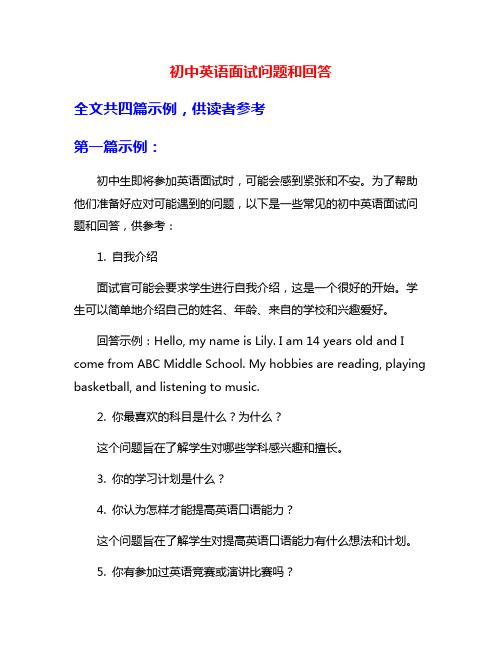
初中英语面试问题和回答全文共四篇示例,供读者参考第一篇示例:初中生即将参加英语面试时,可能会感到紧张和不安。
为了帮助他们准备好应对可能遇到的问题,以下是一些常见的初中英语面试问题和回答,供参考:1. 自我介绍面试官可能会要求学生进行自我介绍,这是一个很好的开始。
学生可以简单地介绍自己的姓名、年龄、来自的学校和兴趣爱好。
回答示例:Hello, my name is Lily. I am 14 years old and I come from ABC Middle School. My hobbies are reading, playing basketball, and listening to music.2. 你最喜欢的科目是什么?为什么?这个问题旨在了解学生对哪些学科感兴趣和擅长。
3. 你的学习计划是什么?4. 你认为怎样才能提高英语口语能力?这个问题旨在了解学生对提高英语口语能力有什么想法和计划。
5. 你有参加过英语竞赛或演讲比赛吗?这个问题旨在了解学生的英语实践经验和成就。
8. 你遇到过困难的时候是怎么应对的?以上是一些常见的初中英语面试问题和回答,希望能帮助学生更好地准备面试,展示自己的英语能力和个人魅力。
祝愿每位初中生在面试中取得优异的表现!第二篇示例:初中英语面试是很多学生在升学阶段所面临的一项挑战。
在面试过程中,面试官通常会提问考生一些基础的英语问题,以考察考生的英语水平和沟通能力。
为了帮助大家更好地准备初中英语面试,下面就给大家整理了一份常见的初中英语面试问题及回答。
1. Can you introduce yourself briefly? (你能简单介绍一下自己吗?)- Yes, sure. My name is Lily and I am 14 years old. I am a student at XXX Middle School. I enjoy playing basketball and reading in my spare time.以上是一些常见的初中英语面试问题及回答,希望这份资料能帮助大家更好地准备初中英语面试。
中学英语教师面试答辩100题
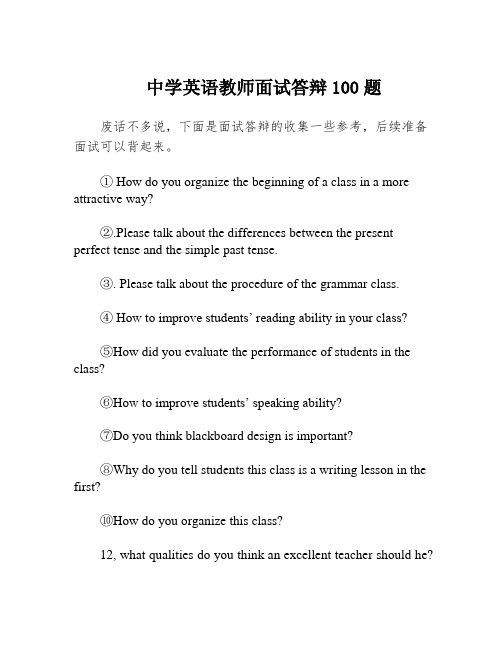
中学英语教师面试答辩100题废话不多说,下面是面试答辩的收集一些参考,后续准备面试可以背起来。
① How do you organize the beginning of a class in a more attractive way?②.Please talk about the differences between the present perfect tense and the simple past tense.③. Please talk about the procedure of the grammar class.④ How to improve students’ reading ability in your class?⑤How did you evaluate the performance of students in the class?⑥How to improve students’ speaking ability?⑦Do you think blackboard design is important?⑧Why do you tell students this class is a writing lesson in the first?⑩How do you organize this class?12, what qualities do you think an excellent teacher should he?15, what are your teaching aims and teaching difficult points?16,could you tell us your teaching procedure?17,make an supplement to 某某知识点 knowledge point1,why do you set this way of leading in ?。
初中英语教资面试题本

初中英语教资面试题本一、教学理念与方法英语教学在初中阶段起着至关重要的作用,既要培养学生的语言技能,又要激发学生学习英语的兴趣。
因此,我的教学理念是以学生为中心,注重培养学生的实际应用能力。
以下是我在面试中常被问到的问题:1.你认为初中英语教学应该注重培养学生的哪些基本技能?在初中英语教学中,我认为应该注重培养学生的听、说、读、写四项基本技能。
听和说是语言交流的基础,通过听力训练和口语练习,学生可以提高自己的听力理解和口语表达能力。
阅读和写作是学生进行深入学习和思考的重要手段,通过阅读和写作练习,学生可以拓宽自己的知识面,培养自己的思维能力和表达能力。
2.在英语教学中,你通常采用哪些教学方法?在英语教学中,我通常采用多种教学方法,根据学生的特点和英语教学的要求灵活运用。
例如,我会结合游戏教学法,通过游戏的形式激发学生学习的兴趣;我也会采用任务型教学法,给学生一些实际的任务,让他们在解决问题的过程中提高自己的语言能力。
此外,我还会借助多媒体教学手段,如投影仪、电脑等,使教学更加生动有趣。
二、课堂管理与布置良好的课堂管理是英语教学的重要环节,它影响着学生的学习效果和教学秩序。
面试中,我常被问到如何管理课堂和布置课堂。
1.你如何管理课堂,保持教学秩序?在管理课堂时,我会提前准备充足的教学内容,并制定详细的教学计划,确保教学进程的有序进行。
我会密切关注学生的学习情况,及时给予他们反馈和指导,并鼓励他们积极参与课堂讨论和活动。
同时,我也会制定一定的纪律规则,并在学生入班时向他们详细介绍,以维护课堂的秩序和学习的氛围。
2.你如何布置课堂,使其更具教学效果?为了使课堂更具教学效果,我会根据不同的教学内容和学习目标进行布置。
例如,如果是口语练习环节,我会采用圆桌式布局,让学生充分参与其中;如果是阅读理解环节,我会将学生分成小组,进行小组合作阅读。
同时,我也会注意课堂的装饰,使用一些与学习内容相关的图片和海报,营造良好的学习氛围。
英语教师面试35个经典问题(一)
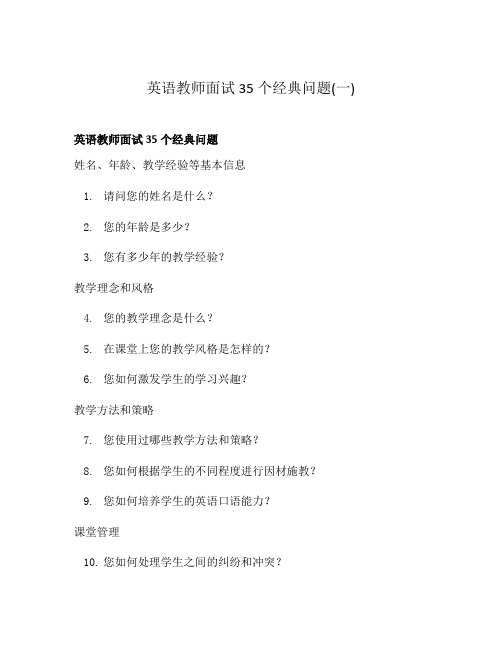
英语教师面试35个经典问题(一)英语教师面试35个经典问题姓名、年龄、教学经验等基本信息1.请问您的姓名是什么?2.您的年龄是多少?3.您有多少年的教学经验?教学理念和风格4.您的教学理念是什么?5.在课堂上您的教学风格是怎样的?6.您如何激发学生的学习兴趣?教学方法和策略7.您使用过哪些教学方法和策略?8.您如何根据学生的不同程度进行因材施教?9.您如何培养学生的英语口语能力?课堂管理10.您如何处理学生之间的纠纷和冲突?11.您如何管理一个活跃的课堂氛围?12.您如何管理学生的注意力和集中精力?多媒体教学13.您如何运用多媒体技术进行教学?14.您有什么创新性的教学活动和项目可以分享?教材和评估15.您如何选择和使用教材?16.您如何评估学生的学习成果?17.您如何给予学生有针对性的反馈?职业发展和自我提升18.您参加过哪些教师培训和进修课程?19.您如何持续提升自己的教学能力?20.您有什么未来的职业规划?与学生和家长的沟通21.您如何与学生建立良好的师生关系?22.您如何与家长进行有效的沟通和合作?承受压力和应对困难23.您在教学中遇到过什么困难,您是如何应对的?24.您如何在工作中平衡好工作与生活?团队合作和领导能力25.您在以往的教学经验中如何与同事合作?26.您是否担任过班级或学校领导职务?个人特质和项目经验27.您具备哪些个人特质使您适合从事英语教学?28.您有哪些与英语教学相关的项目经验?学科知识和专业能力29.您对英语教学的学科知识和专业能力如何?30.您如何保持对英语教学的最新知识的了解?教育背景和资格认证31.您的教育背景和相关学历是什么?32.您有哪些英语教学相关的资格认证?对于英语教育行业的看法和建议33.您对英语教育行业的发展有何看法?34.您对刚步入英语教育行业的教师有什么建议?自由发言35.请您自由发言,补充一些您认为有必要让招聘者了解的信息。
以上是一些面试中可能会遇到的经典问题,通过对这些问题的回答,面试官可以对您的教学能力、专业素养和个人特质有更全面的了解。
初中英语教师资格证面试

初中英语教师资格证面试篇一:初中英语教师资格证面试问题汇总1、学高为师,身正为范。
对此你是怎样理解的?答:学高为师,身正为范是一句古话,它折射的是一种教育的哲理。
我认为“学高为师,身正为范。
”简短数字,精辟概括出教师风范。
“学高为师”说的是教师必须业务精炼,知识面广,有高超的教育教学能力。
因此,教师必须具有渊博的知识,高尚的情操,海一样的胸襟??“身正为范”,指得是“教师的职业是太阳低下最光荣的事业”,担负着培养祖国未来的特殊的历史使命,在学生的心目中,教师是智慧的代表,是高尚人格的化身,教师的言行就是道德标准。
因此,教育工的全部工作就是为人师表,即身正方能为范。
身正就要诚实正直,言行一致,语言文明,仪表大方,态度和蔼可亲,教态高雅洒脱。
时代在前进,形势在发展,知识也在不断更新,要努力做到“学高”“身正”,必须不断勤奋钻研,刻苦学习,加强自身修养。
因此,如果我能成为一名光荣的人民教师,成为一名传播人类文明的使者,在今后的工作中一定要注重为人师表,严格要求自已,从思想作风到生活作风,从言行到举止,从心灵到外表,都应体现教师应有的文明风度和良好的精神面貌,做一个“学高”“身正”的人民教师。
2、现代教学的核心理念是民主平等,你认为在教学中要特别尊重学生的哪些学习行为?答:现代教育的核心理念是民主平等,这也是新课程改革的教学理念,建立民主平等的师是关系可以说是新课程的一项重大变革,建立民主平等的师生关系,必须以教师与学生在教学中互相尊重为原则,因此从教师的角度来说,以下几项是需特别注意的:1、必须让学生的学习个性得到充分的张扬;教师必须把学生当作一个富有生命意义的活生生的人来看待,每一个人都会有自己的个性,教师要充分尊重学生的个性化学习行为;2、教师必须要充分发挥学生的个人特长,学生在学习的过程中肯定会学有所长,也会有一些掌握得不够好的知识,这时教师在尊重学生的兴趣爱好,发展他的特长,而不能以教师的眼光和要求去规范学生,要帮助学生以自己的特长激起学习的兴趣,以充分呵护他们的学习积极性;3、教师必须以平等中的首席出现在学生面前,既是学生学习中的导师,又是和学生一起学习的同伴,要充分理解和关注学生在学习中的困难,以更好地帮助他们解决学习中遇到的问题。
教师资格考试初中面试英语试题与参考答案
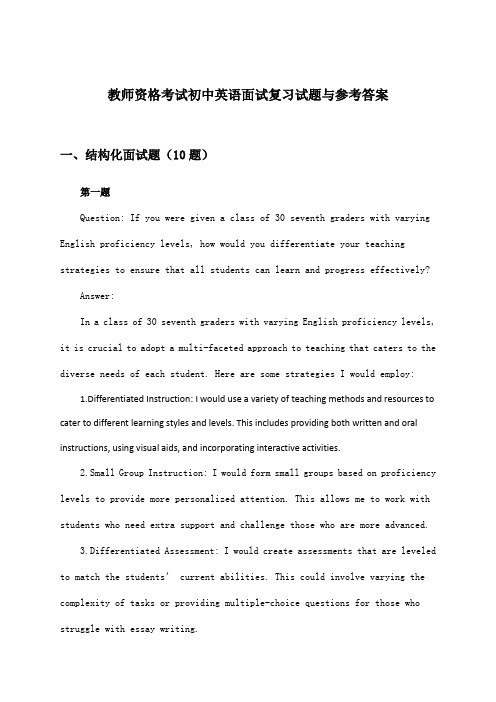
教师资格考试初中英语面试复习试题与参考答案一、结构化面试题(10题)第一题Question: If you were given a class of 30 seventh graders with varying English proficiency levels, how would you differentiate your teaching strategies to ensure that all students can learn and progress effectively?Answer:In a class of 30 seventh graders with varying English proficiency levels, it is crucial to adopt a multi-faceted approach to teaching that caters to the diverse needs of each student. Here are some strategies I would employ:1.Differentiated Instruction: I would use a variety of teaching methods and resources to cater to different learning styles and levels. This includes providing both written and oral instructions, using visual aids, and incorporating interactive activities.2.Small Group Instruction: I would form small groups based on proficiency levels to provide more personalized attention. This allows me to work with students who need extra support and challenge those who are more advanced.3.Differentiated Assessment: I would create assessments that are leveled to match the students’ current abilities. This could involve varying the complexity of tasks or providing multiple-choice questions for those who struggle with essay writing.nguage Support: For students who are still developing their English language skills, I would incorporate language support strategies such as using simplified language, providing glossaries, and using gestures and body language to aid comprehension.5.Encouragement and Motivation: I would make sure to praise and encourage all students, recognizing their efforts and progress. Motivation is key to keeping all students engaged and committed to learning.6.Differentiated Homework: I would assign homework that is appropriate for each student’s level, ensuring that it i s neither too easy nor too difficult. This could involve extension activities for more advanced students and review exercises for those who need extra practice.Explanation:Differentiated instruction is essential in a classroom with diverse learners. By implementing a variety of strategies, I aim to provide an inclusive learning environment where each student feels valued and supported. The focus is on meeting students where they are and helping them to reach their full potential in English language learning.第二题Question:How would you effectively differentiate instruction in your middle school English classroom to cater to the diverse learning styles, abilities, and backgrounds of your students?Answer:In my middle school English classroom, I would employ a variety of strategies to differentiate instruction that accommodate different learning styles, abilities, and backgrounds. Here’s how I would approach this:1.Assessment for Learning: Before planning lessons, I would conduct formative assessments to understand each student’s strengths, weaknesses, and preferred learning modalities. This could include reading comprehension quizzes, writing samples, or speaking and listening exercises.2.Flexible Grouping: I would use flexible grouping techniques, such as mixed-ability or interest-based groups, to create an inclusive learning environment. This allows students to work together, collaborate, and learn from one another.3.Adaptive Instruction: For students with varying abilities, I would provide modified assignments and support. For example, I could offer simpler versions of reading materials for struggling readers or more challenging texts for advanced learners.4.Visual and Auditory Aids: To cater to visual and auditory learners, I would incorporate multimedia resources, such as videos, interactive presentations, and audio recordings, into my lessons.5.Hands-On Activities: For kinesthetic learners, I would incorporate hands-on activities, such as role-playing, group projects, and interactive games, to engage their physical movement and reinforce learning.6.Cultural Responsiveness: Recognizing the diverse backgrounds of mystudents, I would incorporate culturally relevant materials and themes into my teaching. This includes using literature that reflects the experiences and perspectives of various cultures.7.Differentiated Homework: I would assign differentiated homework that allows students to demonstrate their understanding in various ways. Some students might complete a written assignment, while others might create a presentation, a podcast, or a visual representation of the lesson.8.Feedback and Support: I would provide timely and specific feedback to each student, highlighting their strengths and suggesting areas for improvement. Additionally, I would offer support through tutoring sessions or one-on-one conferences.Explanation:Differentiation in the classroom is crucial because it ensures that all students have the opportunity to learn and succeed. By using a combination of these strategies, I can create a dynamic and responsive learning environment that addresses the unique needs of each student. This approach not only enhances student engagement but also fosters a sense of belonging and inclusivity within the classroom.第三题Question: As an English teacher for junior high school, how would you differentiate your teaching methods for students with different learning styles (e.g., auditory, visual, kinesthetic)?Answer:In response to the diverse learning styles of students, I would implement a multifaceted teaching approach that caters to auditory, visual, and kinesthetic learners. Here’s a breakdown of my strategies for each type of learner:1.Auditory Learners:•Incorporate songs, rhymes, and chants into the lessons to reinforce vocabulary and grammar.•Use storytelling techniques to engage students in the narrative, thereby enhancing their listening skills.•Facilitate discussions and group activities that encourage speaking and listening, such as debates or role-playing exercises.2.Visual Learners:•Create visual aids like flashcards, diagrams, and posters to illustrate concepts and vocabulary.•Utilize multimedia resources, such as videos and slideshows, to present information in a visually engaging manner.•Design interactive whiteboards or use projectors to display key points during lessons, allowing students to follow along visually.3.Kinesthetic Learners:•Introduce activities that require physical movement, like “Simon Says”games for vocabulary practice or “Simon Says” for gr ammar exercises.•Encourage students to engage in hands-on projects, such as creating theirown booklets or posters to showcase their understanding of the lesson material.•Use role-playing and simulations to provide kinesthetic learners with a concrete context in which to apply their language skills.By incorporating these diverse teaching methods, I aim to provide a comprehensive learning experience that caters to the varying needs of my students. Additionally, I would continually assess their progress and adjust my strategies as needed to ensure that each student has the opportunity to succeed.Explanation:The answer provided above outlines a comprehensive approach to catering to the different learning styles of students in a junior high school English classroom. It emphasizes the importance of incorporating a variety of teaching methods to engage students with different learning preferences. By addressing auditory, visual, and kinesthetic learners, the teacher demonstrates a commitment to creating an inclusive and supportive learning environment. The explanation provides a rationale for each teaching strategy, highlighting the benefits of using these methods for each type of learner.第四题Question: How would you handle a situation where a student in your class has a strong negative attitude towards learning English, and this attitude is affecting their performance and the class dynamic?Answer:1.Initial Assessment: First, I would observe the student’s behavior and interactionswithin the classroom to understand the root cause of their negative attitude. It’s essential to gather information from various sources such as the student, their peers, and their parents.2.One-on-One Conversation: I would initiate a private conversation with the student to express concern for their well-being and to discuss their feelings about learning English. This allows the student to feel valued and understood.3.Encourage Openness and Empathy: During the conversation, I would encourage the student to share their thoughts and feelings without fear of judgment. I would listen actively and show empathy to build a rapport.4.Identify Challenges: We would identify the specific challenges the student is facing, whether they are related to the curriculum, learning style, peer pressure, or personal issues.5.Tailor Instruction: Based on the identified challenges, I would adapt my teaching methods to better suit the student’s needs. This could include using different resources, adjusting the pace of learning, or incorporating student interests into lesson plans.6.Peer Support: I would encourage positive peer interaction by forming study groups or peer tutoring sessions where students can support each other.7.Positive Reinforcement: I would use positive reinforcement techniques to acknowledge the student’s effort s and progress, regardless of the outcomes, to build their confidence.8.Collaborate with Parents and Guardians: I would involve the student’s parents or guardians in the process to provide additional support and to ensure consistency between home and school.9.Regular Check-ins: I would schedule regular check-ins with the student to monitor their progress and adjust strategies as necessary.10.Professional Development: If the issue persists, I would seek guidance from colleagues, mentors, or professional development resources to refine my approach.Explanation:The key to handling such a situation is to approach it with patience, understanding, and a commitment to the student’s growth. By understanding the underlying reasons for the negative attitude, tailoring the learning experience, and fostering a supportive environment, it is possible to turn around a student’s attitude and improve their performance and the class dynamic. It’s also important to maintain open communication channels with all stakeholders to ensure a holistic approach to the student’s education.第五题Question:As an English teacher for junior high school students, how would you differentiate your teaching methods to cater to students with diverse learning styles, such as visual, auditory, and kinesthetic learners?Answer:As an English teacher aiming to cater to students with diverse learning styles, I would adopt a multifaceted approach that integrates various teaching methods to engage all types of learners. Here’s how I would differentiate myteaching for visual, auditory, and kinesthetic learners:1.Visual Learners:•Use visual aids such as flashcards, posters, and diagrams to illustrate vocabulary and grammar points.•Create presentations and videos that include visual examples of language use in real-world contexts.•Encourage students to create their own visual summaries of texts or stories they have read.2.Auditory Learners:•Incorporate songs, poems, and dialogues into lessons to reinforce language learning through listening.•Conduct discussions and group activities where students can engage in verbal interactions.•Use storytelling and role-plays to help auditory learners absorb and remember the language.3.Kinesthetic Learners:•Design activities that involve physical movement, such as “Simon Says”games or theater exercises to practice language.•Incorporate hands-on activities like making models or dioramas to represent stories or concepts.•Encourage kinesthetic learners to act out scenes or use puppets to express their understanding of the material.Explanation:Differentiating instruction is essential to ensure that all students have the opportunity to learn effectively. By recognizing and addressing the specific needs of visual, auditory, and kinesthetic learners, I can create a classroom environment that caters to their preferences and strengths. This approach not only helps to engage all students but also enhances their overall language acquisition and retention. Additionally, it fosters a more inclusive classroom where students feel valued and understood, leading to higher levels of motivation and success.第六题Question:If you were teaching a group of初中 students who were struggling with understanding the past perfect tense, how would you adapt your teaching methods to ensure they grasp the concept effectively?Answer:1.Assess Understanding: Begin by assessing the students’ current understanding of the past perfect tense through a brief quiz or discussion. This will help identify their specific areas of confusion.e Real-Life Examples: Present real-life examples that naturally incorporate the past perfect tense. For instance, you could discuss a historical event and use sentences like, “The Great Wall had been built for centuries before the tourists arrived.”3.Visual Aids: Create visual aids such as timelines or storyboards to illustrate the sequence of events that require the use of the past perfect tense.This can help students visualize the concept.4.Interactive Activities: Engage students in interactive activities such as role-playing, where they can practice using the past perfect tense in context. For example, students could act out a scenario where one person asks about another’s past experiences.5.Collaborative Learning: Pair students up or form small groups to discuss and create sentences using the past perfect tense. This encourages peer learning and can help clarify misunderstandings.6.Consistent Practice: Incorporate regular practice sessions into your lessons, where students can practice forming and using past perfect tense sentences. This could include completing worksheets, online exercises, or oral drills.7.Differentiated Instruction: Recognize that students have different learning styles. Offer alternative methods such as video tutorials, audio recordings, or written explanations for those who may need additional support.8.Feedback and Adjustment: Provide immediate feedback on students’ usage of the past perfect tense and be prepared to adjust your teaching methods based on their progress and feedback.Explanation:The key to teaching the past perfect tense effectively to struggling students lies in making the concept relatable and accessible. By using real-life examples, visual aids, and interactive activities, students can engage with the materialin a way that resonates with them. Additionally, by offering a variety of teaching methods and allowing for collaborative learning, students can learn from each other and reinforce their understanding. Regular practice and personalized feedback ensure that each student receives the support they need to master the concept.第七题Question:Discuss the importance of integrating technology in teaching English to junior high school students and provide an example of how you would use technology in your classroom.Answer:Integrating technology into the teaching of English to junior high school students is essential for several reasons. Firstly, it enhances student engagement by providing interactive and dynamic learning experiences that can cater to different learning styles. Secondly, technology facilitates access to a vast array of resources, such as authentic materials from English-speaking countries, which can improve students’ language skills and cultural understanding. Additionally, using technology can help prepare students for a digital world where online communication and digital literacy are increasingly important.For example, I could incorporate a video project into my lesson plan where students work in groups to create short films or presentations on topics relatedto the curriculum. They would be required to research their topic, write scripts, record videos, and edit them using software like iMovie or Windows Movie Maker. This activity not only promotes collaborative learning and creativity but also provides practical experience with digital tools that are relevant to today’s job market. Furthermore, by sharing these projects with the class, students can practice their speaking and listening skills while receiving constructive feedback from their peers and teacher.Explanation:This question assesses the candidate’s ability to recognize the benefits of using technology in education and apply this knowledge practically. The answer provided demonstrates an understanding of how technology can enhance the learning environment and support the development of 21st-century skills. By giving a specific example of a video project, the response shows that the teacher can effectively integrate technology into the curriculum in a way that aligns with educational goals and fosters student engagement and collaboration.第八题Question: If you were teaching a class of students who had a diverse range of English proficiency levels, how would you differentiate your instruction to meet their individual needs and ensure that all students can participate effectively in the learning process?Answer:In a class with diverse English proficiency levels, I would implement thefollowing strategies to differentiate instruction and ensure effective participation from all students:1.Assessment and Grouping: Start by assessing the students’ current English proficiency levels through oral and written assessments. Based on these results, I would formmixed-ability groups where students with similar proficiency levels are placed together, but also ensure that there are opportunities for collaboration across groups.nguage Simplification: For students with lower proficiency, I would simplify the language by using clear, concise sentences and vocabulary that they can understand. I would also use visual aids, gestures, and body language to complement my verbal explanations.3.Task Differentiation: Assign tasks that cater to different proficiency levels. For example, advanced students might be given more complex projects or discussions, while lower-level students could focus on simpler tasks like vocabulary practice or basic sentence structure exercises.4.Interactive and Collaborative Activities: Incorporate interactive activities that encourage collaboration and peer support. This allows students to learn from each other and build confidence in their language abilities.5.Feedback and Encouragement: Provide regular, constructive feedback that focuses on improvement rather than criticism. Encourage students to set personal goals and celebrate their progress, regardless of their proficiency level.6.Differentiated Instructional Materials: Use a variety of resources and materials that are appropriate for different levels. This might include simplified textbooks, online resources, or additional worksheets for strugglingstudents.7.Flexible Learning Environment: Create a flexible learning environment where students can work at their own pace. This could involve allowing students to choose from a range of activities or giving them additional time to complete tasks.8.Parental Involvement: Keep parents info rmed about their child’s progress and involve them in the learning process. This could include sending home activity sheets or providing suggestions for language practice at home.By implementing these strategies, I can ensure that all students in the class have the opportunity to learn and participate effectively, regardless of their initial English proficiency level.Explanation:The answer provided outlines a comprehensive approach to managing a diverse class in terms of English proficiency. It addresses the need for both formative and summative assessment to inform instruction, the importance of differentiating tasks and materials, and the role of a supportive and interactive classroom environment. Additionally, it recognizes the value of parental involv ement in supporting students’ language development outside of school.Ninth QuestionQuestion: Describe a situation where you had to adapt your teaching methodology to accommodate a student with special learning needs. What specificstrategies did you employ to ensure their inclusion and academic success?Answer Example:“In my previous teaching experience, I encountered a student who had dyslexia, which made it challenging for them to read at the same pace as their peers. To address this, I implemented several strategies to support their learning process. Firstly, I utilized audio books and text-to-speech software that helped the student engage with the material on a more accessible level. Secondly, I provided written materials well ahead of time so that they could prepare and familiarize themselves with the content. Additionally, I encouraged peer-assisted learning, pairing the student with a classmate who could assist during group activities while promoting an inclusive classroom environment. Lastly, I ensured regular one-on-one sessions to discuss any difficulties and to tailor assignments that matched their learning pace. This approach not only supported the student’s academic progress but also fostered a sense of belonging and self-esteem within the clas sroom.”Analysis:This answer demonstrates the candidate’s ability to recognize individual learning differences and implement inclusive practices. The strategies mentioned show adaptability, resourcefulness, and a commitment to creating an equitable learning environment. By outlining specific tools and methods used (audio books, text-to-speech software, advanced preparation, peer assistance, and personalized attention), the candidate illustrates practical applicationof educational theories. Moreover, the emphasis on emotional well-being and self-esteem indicates a holistic approach to education, which is crucial for supporting students with special learning needs.第十题Question:How would you handle a situation where a student in your class is consistently disruptive and disrespectful towards both the teacher and their peers?Answer:As a teacher, addressing disruptive behavior is crucial for maintaining a positive and productive learning environment. Here’s how I would handle sucha situation:1.Immediate Intervention: First and foremost, I would address the behavior immediately. I would approach the student calmly and privately, ensuring they understand that their actions are inappropriate and disruptive to the learning process.munication: I would have a conversation with the student, asking them to explain their behavior. It’s essential to listen actively and without judgment to understand the root cause of the disruption. This may involve discussing their feelings, experiences, or any external factors that might be contributing to their behavior.3.Consistent Rules and Consequences: I would remind the student of the classroom rules and the consequences of breaking them. It’s important to be consistent with the rules and the consequences to avoid confusion and reinforce the importance of respecting others.4.Behavior Contract: If the disruptive behavior continues, I would createa behavior contract with the student. This contract would outline specific expectations, goals, and the consequences of not meeting those goals. Regular check-ins and feedback would be provided to monitor progress.5.Collaboration with Parents or Guardians: In some cases, involving the student’s parents or guardians may be necessary. I would communicate with them about the student’s behavior, seek their support, and discuss strategies that can be implemented at home and school.6.Classroom Support: If the disruptive behavior affects the entire class,I would work with the students to create a supportive environment. This could involve group discussions, role-playing scenarios, or team-building activities to promote respect and cooperation among classmates.7.Professional Development: As a teacher, I would also engage in professional development opportunities to enhance my skills in dealing with disruptive behavior. This could include workshops, webinars, or seeking guidance from colleagues who have experience in this area.Explanation:It’s essential to address disruptive behavior promptly and effectively to maintain a positive learning environment. By taking a proactive approach, listening to the student, implementing consistent rules, and involving parents or guardians when necessary, teachers can help students understand the importance of respect and cooperation. Additionally, seeking professionaldevelopment opportunities ensures that teachers have the necessary tools and strategies to handle such situations effectively.二、教案设计题(3题)第一题Title:“Teaching Plan for a Junior High School English Lesson on”The Weather”Answer:Objective:1.To enable students to understand and use simple sentences to describe weather conditions.2.To enhance students’ ability to communicate in English about daily weather observations.3.To develop students’ vocabulary and grammar skills related to weather expressions.Teaching Aids:•Whiteboard and markers•Flashcards with weather-related vocabulary•Weather forecast videos or pictures•Handouts for homeworkTeaching Procedure:1.Introduction (5 minutes)•Begin the lesson by asking students to share their favorite weather and why. This will stimulate their interest and provide a context for the lesson.•Show a brief video or pictures of different weather conditions to introduce the lesson topic.2.Vocabulary Presentation (10 minutes)•Introduce new vocabulary words related to weather using flashcards. For example: sunny, cloudy, rainy, windy, stormy, etc.•Have students practice reading and pronouncing these words aloud. •Provide a brief explanation of each word and its usage in a sentence.3.Grammar Presentation (10 minutes)•Introduce the simple present tense to describe weather conditions. Use examples like “It is sunny,” “It is cloudy,” etc.•Explain the structure and usage of the simple present tense for describing weather.•Have students practice forming sentences using the simple present tense with weather words.4.Practice (15 minutes)•Divide the class into small groups and ask them to create a dialogue about weather observations using the new vocabulary and grammar. •Circulate around the classroom to provide guidance and correct any errors. •Have each group present their dialogue to the class.5.Homework Assignment (5 minutes)•Assign a homework task where students are required to write a short paragraph describing a day’s weather in their hometown using the new vocabulary andgrammar.Evaluation:•Observe students’ participation and understanding during the vocabulary and grammar presentations.•Assess students’ ability to form sentences using the simp le present tense for describing weather.•Evaluate the quality of the group dialogues and the homework assignments.Explanation:This teaching plan focuses on introducing and practicing weather-related vocabulary and grammar in a junior high school English class. By using a variety of teaching methods, such as vocabulary flashcards, grammar explanations, group work, and homework assignments, the teacher aims to provide students with a comprehensive understanding of weather-related language and enhance their communication skills. The plan is designed to be interactive and engaging, encouraging students to actively participate in the learning process.第二题题目背景: 假设您是一名初中英语教师,您的班级学生年龄在13至15岁之间,英语水平为中级。
英语教师的面试问题答案与结构

英语教师的面试问题答案与结构问题1:请简要介绍一下您的教育背景和相关教学经验。
回答:我拥有硕士学位并取得了英语教育专业的学士学位。
我在过去的五年里一直在一所私立学校担任英语教师,教授初中和高中学生。
我还参与了一些教育培训项目,包括教学方法的改进和学生评估的实施。
问题2:您认为什么是有效的英语教学方法?回答:我认为有效的英语教学方法应该结合听、说、读、写四大技能的培养。
我会采用互动式教学,鼓励学生参与到课堂活动中,以提高他们的口语表达能力。
此外,我会通过多媒体和实际案例来激发学生的学习兴趣,并鼓励他们积极运用所学知识。
问题3:您是如何评估学生的英语水平和进步的?回答:我会使用多种评估方法来评估学生的英语水平和进步。
包括课堂表现、小组讨论、书面作业和考试等。
我还会定期与学生和家长进行沟通,了解他们在学习上的困难和进步,并根据评估结果调整教学策略,以帮助学生更好地提高。
问题4:您在面对学生学习困难时会采取什么措施?回答:当学生遇到学习困难时,我会与他们进行一对一的辅导,并找出问题所在。
我会尝试不同的教学方法,以更好地满足学生的学习需求。
我还会鼓励学生互相合作,组成学习小组,促进彼此之间的学习帮助和分享。
问题5:您认为如何与家长保持有效的沟通?回答:与家长保持有效的沟通对于学生的学习非常重要。
我会定期与家长进行面谈或通过电子邮件进行沟通,及时向他们反馈学生的学习情况和表现。
我会尊重家长的意见和建议,并与他们合作,共同关心学生的学习和发展。
问题6:您在教学中遇到的最大挑战是什么?回答:在教学中,我遇到的最大挑战是满足不同学生的学习需求和能力差异。
每个学生都有自己的学习方式和进步速度,我需要灵活地调整教学策略,以确保每个学生都能够获得有效的学习成果。
问题7:您在课余时间如何提升自己的教学能力?回答:我认为不断提升自己的教学能力是作为一名教师的责任。
在课余时间,我会参加教育培训课程和研讨会,了解最新的教学方法和教育理论。
应聘英语老师面试问题

应聘英语老师面试问题
1. 个人背景和经验
- 自我介绍:请简单介绍一下你自己的教育背景和相关工作经验。
- 为什么选择从事英语教育工作?请分享你的动机和热爱。
- 你认为你的教学方法和理念有何特点?请详细说明。
2. 教学方法和策略
- 你对于教授听说读写四个方面的英语技能有何见解?
- 如何提高学生的口语表达能力?
- 你如何培养学生的英语写作能力?
- 怎样让英语研究变得有趣并激发学生的研究兴趣?
3. 课堂管理和沟通能力
- 你如何管理一个英语课堂的纪律和秩序?
- 如何与学生家长保持有效的沟通?
- 请描述一次你成功解决教学中的冲突或挑战的经历。
4. 学生评估和个性化教学
- 你如何评估学生的英语水平和研究进展?
- 如何根据学生的特点和需求进行个性化教学?
- 请举例说明如何帮助一个英语水平较低的学生取得进步。
5. 师德和专业发展
- 你认为作为一名英语老师应具备的师德是什么?
- 如何进行自我反思和专业发展?
- 你参加过哪些与英语教育相关的培训或研讨会?
6. 结束语
- 请简要总结一下你作为一名英语老师的优势和动力。
以上是一些在面试中经常出现的问题,希望你能提前做好准备。
祝你面试顺利!
---
*注意:以上问题仅供参考,具体的面试问题可能因学校和职
位要求而有所不同。
建议你根据具体的招聘信息和岗位需求来准备
面试答案。
祝你成功!*。
初中英语教师面试题目(3篇)
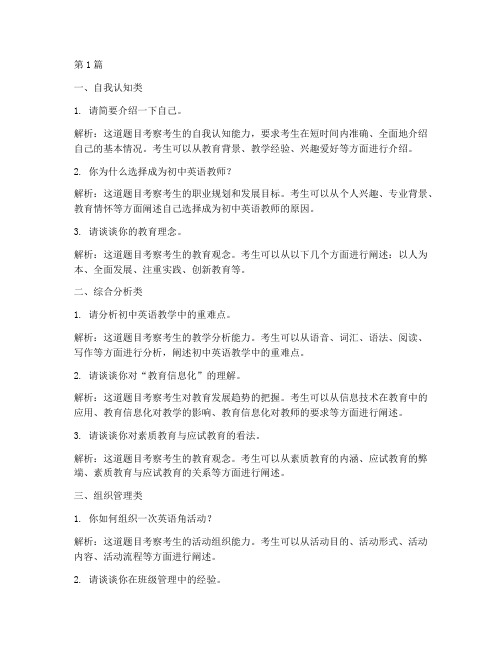
第1篇一、自我认知类1. 请简要介绍一下自己。
解析:这道题目考察考生的自我认知能力,要求考生在短时间内准确、全面地介绍自己的基本情况。
考生可以从教育背景、教学经验、兴趣爱好等方面进行介绍。
2. 你为什么选择成为初中英语教师?解析:这道题目考察考生的职业规划和发展目标。
考生可以从个人兴趣、专业背景、教育情怀等方面阐述自己选择成为初中英语教师的原因。
3. 请谈谈你的教育理念。
解析:这道题目考察考生的教育观念。
考生可以从以下几个方面进行阐述:以人为本、全面发展、注重实践、创新教育等。
二、综合分析类1. 请分析初中英语教学中的重难点。
解析:这道题目考察考生的教学分析能力。
考生可以从语音、词汇、语法、阅读、写作等方面进行分析,阐述初中英语教学中的重难点。
2. 请谈谈你对“教育信息化”的理解。
解析:这道题目考察考生对教育发展趋势的把握。
考生可以从信息技术在教育中的应用、教育信息化对教学的影响、教育信息化对教师的要求等方面进行阐述。
3. 请谈谈你对素质教育与应试教育的看法。
解析:这道题目考察考生的教育观念。
考生可以从素质教育的内涵、应试教育的弊端、素质教育与应试教育的关系等方面进行阐述。
三、组织管理类1. 你如何组织一次英语角活动?解析:这道题目考察考生的活动组织能力。
考生可以从活动目的、活动形式、活动内容、活动流程等方面进行阐述。
2. 请谈谈你在班级管理中的经验。
解析:这道题目考察考生的班级管理能力。
考生可以从班级制度建设、学生行为规范、家校沟通等方面进行阐述。
3. 请谈谈你如何处理学生之间的矛盾?解析:这道题目考察考生的应急应变能力。
考生可以从沟通协调、公正处理、心理疏导等方面进行阐述。
四、人际交往类1. 请谈谈你与同事之间如何相处?解析:这道题目考察考生的人际沟通能力。
考生可以从相互尊重、团结协作、共同进步等方面进行阐述。
2. 请谈谈你如何与学生家长进行沟通?解析:这道题目考察考生的家校沟通能力。
考生可以从倾听家长意见、尊重家长、有效沟通等方面进行阐述。
英语教师面试的提问大全

英语教师面试的提问大全
以下是英语教师面试可能会被问到的问题:
教学相关
1. 你如何评估学生的英语水平?
2. 你会如何设计教学计划?
3. 你如何帮助学生克服英语研究中的难点?
4. 你使用过哪些有效的教学方法?
5. 你如何处理学生的研究问题?
英语知识相关
1. 你对语法的了解有多少?
2. 你擅长哪些英语技能,如听、说、读、写?
3. 你了解哪些英文作家和作品?
4. 你能否在两分钟内解释三个英语语言术语的含义?
5. 你能否讲一下英语中不同的口音以及它们之间的差别?
学校文化和教育理念相关
1. 你对本校的教育理念和文化有什么了解?
2. 你有没有自己的教育理念?
3. 你觉得教育目标是什么?
4. 你如何帮助学生发展个人与团体性格?
5. 你如何帮助学生实现自我目标和职业目标?
个人相关
1. 你为什么想要成为一名英语教师?
2. 你的职业规划和目标是什么?
3. 你的优点和缺点是什么?
4. 你如何自我评价你的英语水平?
5. 你如何处理和激励自己的情绪?
这只是一些可能被问到的问题,你在备战面试时应该更多关注自己的专业技能,多与他人交流和讨论,提升面试能力。
面试英语老师的十五个问题
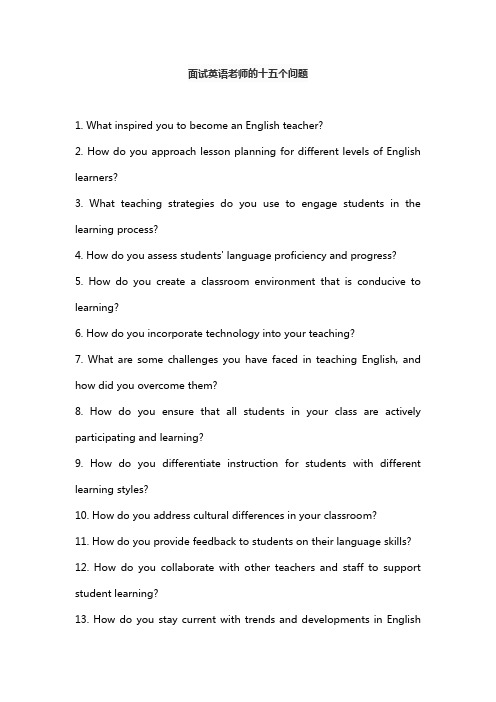
面试英语老师的十五个问题1. What inspired you to become an English teacher?2. How do you approach lesson planning for different levels of English learners?3. What teaching strategies do you use to engage students in the learning process?4. How do you assess students' language proficiency and progress?5. How do you create a classroom environment that is conducive to learning?6. How do you incorporate technology into your teaching?7. What are some challenges you have faced in teaching English, and how did you overcome them?8. How do you ensure that all students in your class are actively participating and learning?9. How do you differentiate instruction for students with different learning styles?10. How do you address cultural differences in your classroom?11. How do you provide feedback to students on their language skills?12. How do you collaborate with other teachers and staff to support student learning?13. How do you stay current with trends and developments in Englishlanguage teaching?14. How do you promote language learning outside of the classroom?15. How do you encourage students to take ownership of their own learning?翻译:1.是什么激励你成为一名英语老师?2.你如何为不同水平的英语学习者制定课程计划?3.你用什么教学策略来吸引学生参与学习过程?4.你如何评估学生的语言能力和进步?5.你如何创造一个有利于学习的课堂环境?6.你是如何将技术融入教学的?7.你在英语教学中遇到了哪些挑战,你是如何克服的?8.你如何确保班上的所有学生都积极参与和学习?9.你如何区分不同学习风格的学生的教学?10.你如何解决课堂上的文化差异?11.你如何就学生的语言技能向他们提供反馈?12.你如何与其他教师和工作人员合作支持学生学习?13.你如何掌握英语教学的最新趋势和发展?14.你如何在课堂之外促进语言学习?15.你如何鼓励学生自主学习?。
英语初中教师面试题目(3篇)
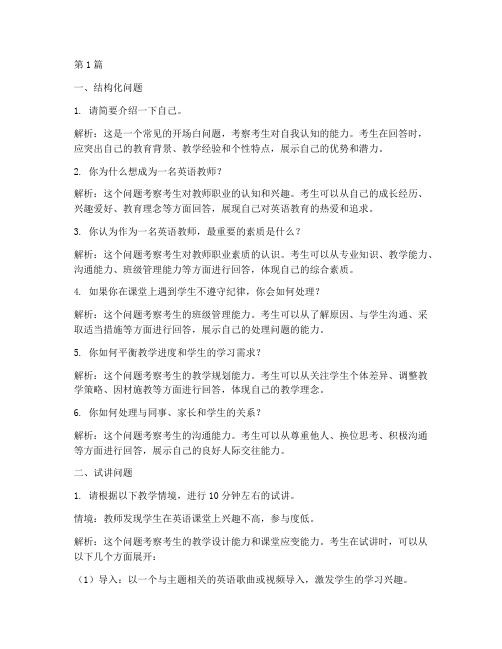
第1篇一、结构化问题1. 请简要介绍一下自己。
解析:这是一个常见的开场白问题,考察考生对自我认知的能力。
考生在回答时,应突出自己的教育背景、教学经验和个性特点,展示自己的优势和潜力。
2. 你为什么想成为一名英语教师?解析:这个问题考察考生对教师职业的认知和兴趣。
考生可以从自己的成长经历、兴趣爱好、教育理念等方面回答,展现自己对英语教育的热爱和追求。
3. 你认为作为一名英语教师,最重要的素质是什么?解析:这个问题考察考生对教师职业素质的认识。
考生可以从专业知识、教学能力、沟通能力、班级管理能力等方面进行回答,体现自己的综合素质。
4. 如果你在课堂上遇到学生不遵守纪律,你会如何处理?解析:这个问题考察考生的班级管理能力。
考生可以从了解原因、与学生沟通、采取适当措施等方面进行回答,展示自己的处理问题的能力。
5. 你如何平衡教学进度和学生的学习需求?解析:这个问题考察考生的教学规划能力。
考生可以从关注学生个体差异、调整教学策略、因材施教等方面进行回答,体现自己的教学理念。
6. 你如何处理与同事、家长和学生的关系?解析:这个问题考察考生的沟通能力。
考生可以从尊重他人、换位思考、积极沟通等方面进行回答,展示自己的良好人际交往能力。
二、试讲问题1. 请根据以下教学情境,进行10分钟左右的试讲。
情境:教师发现学生在英语课堂上兴趣不高,参与度低。
解析:这个问题考察考生的教学设计能力和课堂应变能力。
考生在试讲时,可以从以下几个方面展开:(1)导入:以一个与主题相关的英语歌曲或视频导入,激发学生的学习兴趣。
(2)新授:通过游戏、情景模拟等方式,让学生在轻松愉快的氛围中学习新知识。
(3)巩固:设置练习题,让学生在小组合作或个人练习中巩固所学知识。
(4)总结:总结本节课的学习内容,强调重点和难点。
2. 请根据以下教学目标,进行10分钟左右的试讲。
目标:让学生掌握一般过去时的构成和用法。
解析:这个问题考察考生的教学设计能力和课堂实施能力。
初中英语教师资格证面试题

初中英语汇总一、1.题目: The Science Museum in London2.内容:In most museums, there is no shouting and no running, and you must not touch anything. But the Science Museum is different. It is noisy! People talk about what they can see and do here and there are some very noisy machines as well .If you want answers to allyour questions about science, this is the right place for you.The Launchpad on the third floor is the most popular room.Because there are lots of physics experiments. For example, if you want to fill a bag with sand, you have to control a kind of truck on heels and move it into the correct place.On the fourth and fifth floors, you can learn about what medicine was like in the past. If you compare the medicine of the past with the medicine of today, you will feel very lucky next time you visita doctor!3.基本要求:(1) 讲解if状语从句;(2) 朗读一遍;(3) 全英试讲,讲解10分钟。
英语教师面试提问_经典的英语面试提问优秀7篇
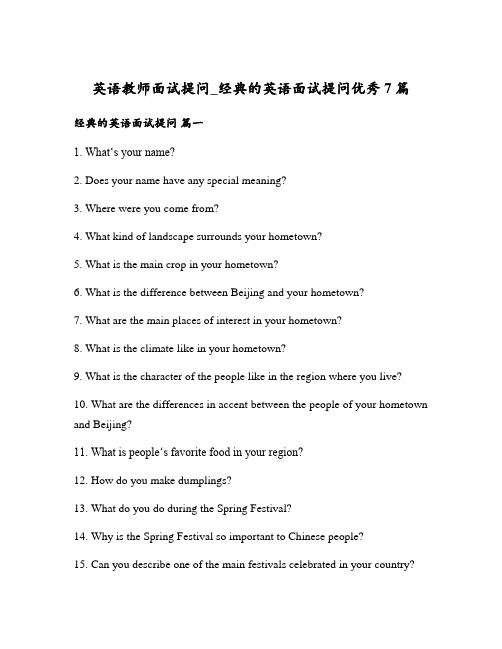
英语教师面试提问_经典的英语面试提问优秀7篇经典的英语面试提问篇一1. What‘s your name?2. Does your name have any special meaning?3. Where were you come from?4. What kind of landscape surrounds your hometown?5. What is the main crop in your hometown?6. What is the difference between Beijing and your hometown?7. What are the main places of interest in your hometown?8. What is the climate like in your hometown?9. What is the character of the people like in the region where you live?10. What are the differences in accent between the people of your hometown and Beijing?11. What is people‘s favorite food in your region?12. How do you make dumplings?13. What do you do during the Spring Festival?14. Why is the Spring Festival so important to Chinese people?15. Can you describe one of the main festivals celebrated in your country?16. Tell me something about the Lantern Festival.17. Tell me something about the Qing Ming Festival.18. Tell me something about the customs of your country.19. How long have you lived in Beijing?20. What is the weather like in Beijing?21. How do you compare the climate in Beijing with that in your hometown?22. What place in Beijing do you like best? Why ?23. Which is the worst place you‘ve been to China?24. Which is the best place you‘ve been t o China?25. What places in Beijing should a foreigner visit? Why?26. What are the major social problems in Beijing? How can they be solved?27. What is the biggest problem China faces?28. What places in Beijing should a foreigner visit? Why?29. Could you tell me something about your family?30. Have you any children?英语面试常见问题篇二英语面试中除了要求表述自己以前的工作情况和求职经历以外。
中学英语教师面试常见问题
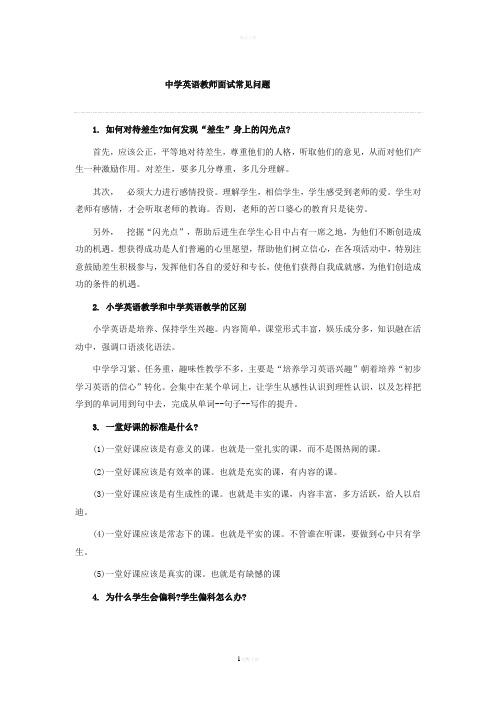
中学英语教师面试常见问题1. 如何对待差生?如何发现“差生”身上的闪光点?首先,应该公正,平等地对待差生,尊重他们的人格,听取他们的意见,从而对他们产生一种激励作用。
对差生,要多几分尊重,多几分理解。
其次,必须大力进行感情投资。
理解学生,相信学生,学生感受到老师的爱。
学生对老师有感情,才会听取老师的教诲。
否则,老师的苦口婆心的教育只是徒劳。
另外,挖掘“闪光点”,帮助后进生在学生心目中占有一席之地,为他们不断创造成功的机遇。
想获得成功是人们普遍的心里愿望,帮助他们树立信心,在各项活动中,特别注意鼓励差生积极参与,发挥他们各自的爱好和专长,使他们获得自我成就感,为他们创造成功的条件的机遇。
2. 小学英语教学和中学英语教学的区别小学英语是培养、保持学生兴趣。
内容简单,课堂形式丰富,娱乐成分多,知识融在活动中,强调口语淡化语法。
中学学习紧、任务重,趣味性教学不多,主要是“培养学习英语兴趣”朝着培养“初步学习英语的信心”转化。
会集中在某个单词上,让学生从感性认识到理性认识,以及怎样把学到的单词用到句中去,完成从单词--句子--写作的提升。
3. 一堂好课的标准是什么?(1)一堂好课应该是有意义的课。
也就是一堂扎实的课,而不是图热闹的课。
(2)一堂好课应该是有效率的课。
也就是充实的课,有内容的课。
(3)一堂好课应该是有生成性的课。
也就是丰实的课,内容丰富,多方活跃,给人以启迪。
(4)一堂好课应该是常态下的课。
也就是平实的课。
不管谁在听课,要做到心中只有学生。
(5)一堂好课应该是真实的课。
也就是有缺憾的课4. 为什么学生会偏科?学生偏科怎么办?学生偏科有很多因素,一方面是对这门课程的兴趣和态度。
学生无论学哪一门学科,都可能由于种种原因出现一些知识漏洞,,如果家长和老师也没太注意,学生的漏洞就可能扩大,大到一定程度,就听不懂新课了,这种情况理科和外语最明显。
学生越听不懂越不爱学,不爱学就更跟不上。
在情感上厌恶和躲避这门课,于是偏科了。
初中英语教研员面试题目(3篇)
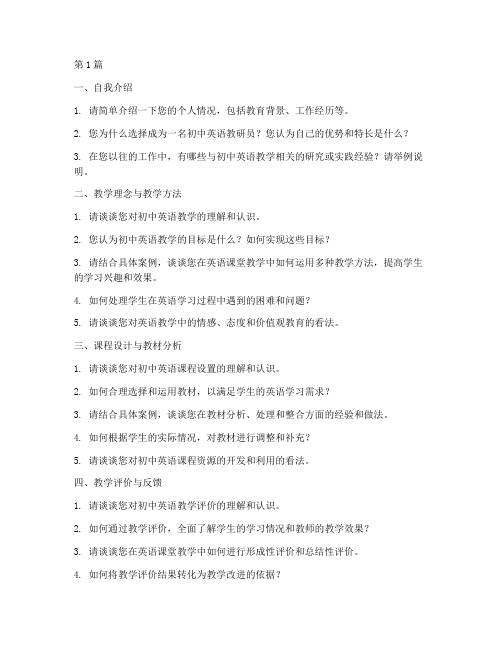
第1篇一、自我介绍1. 请简单介绍一下您的个人情况,包括教育背景、工作经历等。
2. 您为什么选择成为一名初中英语教研员?您认为自己的优势和特长是什么?3. 在您以往的工作中,有哪些与初中英语教学相关的研究或实践经验?请举例说明。
二、教学理念与教学方法1. 请谈谈您对初中英语教学的理解和认识。
2. 您认为初中英语教学的目标是什么?如何实现这些目标?3. 请结合具体案例,谈谈您在英语课堂教学中如何运用多种教学方法,提高学生的学习兴趣和效果。
4. 如何处理学生在英语学习过程中遇到的困难和问题?5. 请谈谈您对英语教学中的情感、态度和价值观教育的看法。
三、课程设计与教材分析1. 请谈谈您对初中英语课程设置的理解和认识。
2. 如何合理选择和运用教材,以满足学生的英语学习需求?3. 请结合具体案例,谈谈您在教材分析、处理和整合方面的经验和做法。
4. 如何根据学生的实际情况,对教材进行调整和补充?5. 请谈谈您对初中英语课程资源的开发和利用的看法。
四、教学评价与反馈1. 请谈谈您对初中英语教学评价的理解和认识。
2. 如何通过教学评价,全面了解学生的学习情况和教师的教学效果?3. 请谈谈您在英语课堂教学中如何进行形成性评价和总结性评价。
4. 如何将教学评价结果转化为教学改进的依据?5. 请谈谈您对家长、学生和教师反馈的重视程度及处理方法。
五、教研工作与团队建设1. 请谈谈您对初中英语教研工作的理解和认识。
2. 如何开展有效的教研活动,提高教师的专业素养和教学水平?3. 请谈谈您在团队建设方面的经验和做法。
4. 如何协调好教研工作与其他教育教学工作的关系?5. 请谈谈您对教研员在教育教学改革中的作用和责任的认识。
六、信息技术与英语教学1. 请谈谈您对信息技术在英语教学中的应用的理解和认识。
2. 如何利用信息技术提高英语课堂教学效果?3. 请谈谈您在信息技术与英语教学整合方面的经验和做法。
4. 如何帮助教师掌握和应用信息技术?5. 请谈谈您对信息技术在英语教学评价中的应用的看法。
英语教师面试:关键问题及答案

英语教师面试:关键问题及答案1. 请简要介绍一下自己。
我是一名热爱教育事业的英语教师。
拥有X年的英语教学经验,曾在多所学校任教。
我对教育有着深入的理解和独特的教学方法,能够激发学生的研究兴趣,提高他们的英语能力。
2. 你认为什么是成功的英语教学?成功的英语教学应该能够激发学生的研究兴趣,提高他们的英语能力,并培养他们的语言运用能力和沟通技巧。
成功的英语教学还应该注重学生的全面发展,培养他们的创造力、批判性思维和合作能力。
3. 你如何激发学生的研究兴趣?我相信激发学生的研究兴趣是成功教学的关键。
我会运用多种教学方法,如游戏、实践活动和多媒体资源,使课堂更加生动有趣。
我还会关注学生的个人兴趣和需求,根据他们的喜好调整教学内容,使研究更具针对性和吸引力。
4. 请分享一次你成功帮助学生提高英语能力的经历。
在我之前的一所学校任教期间,有一名学生在英语研究方面一直遇到困难。
通过与他的沟通和了解,我发现他缺乏自信和研究动力。
于是,我采用了一些激励方法,如鼓励他参加英语演讲比赛,并给予他额外的支持和指导。
经过一段时间的努力,这位学生逐渐展示出了自己的才华和潜力,英语能力也得到了明显提高。
5. 你如何处理学生之间的纷争或冲突?处理学生之间的纷争或冲突需要耐心和公正。
我会先听取双方的陈述,并尽量理解彼此的立场。
然后,我会引导他们进行有效的沟通,帮助他们找到解决问题的方法。
在处理冲突过程中,我会秉持公正原则,不偏袒任何一方,并促使他们相互尊重和理解。
6. 你如何评估学生的英语能力?评估学生的英语能力是教学过程中必不可少的一环。
我会运用多种评估方法,包括口语和书面测试、课堂表现观察以及项目作业等。
我还会定期与学生进行个别沟通,了解他们的研究进展和困难,并根据评估结果调整教学计划,帮助他们更好地提高英语能力。
7. 你如何与家长保持有效的沟通?与家长保持有效的沟通是促进学生研究的重要环节。
我会定期组织家长会,与家长面对面交流学生的研究情况和表现。
- 1、下载文档前请自行甄别文档内容的完整性,平台不提供额外的编辑、内容补充、找答案等附加服务。
- 2、"仅部分预览"的文档,不可在线预览部分如存在完整性等问题,可反馈申请退款(可完整预览的文档不适用该条件!)。
- 3、如文档侵犯您的权益,请联系客服反馈,我们会尽快为您处理(人工客服工作时间:9:00-18:30)。
中学英语教师面试常见
问题
work Information Technology Company.2020YEAR
中学英语教师面试常见问题
1. 如何对待差生?如何发现“差生”身上的闪光点?
首先,应该公正,平等地对待差生,尊重他们的人格,听取他们的意见,从而对他们产生一种激励作用。
对差生,要多几分尊重,多几分理解。
其次,必须大力进行感情投资。
理解学生,相信学生,学生感受到老师的爱。
学生对老师有感情,才会听取老师的教诲。
否则,老师的苦口婆心的教育只是徒劳。
另外,挖掘“闪光点”,帮助后进生在学生心目中占有一席之地,为他们不断创造成功的机遇。
想获得成功是人们普遍的心里愿望,帮助他们树立信心,在各项活动中,特别注意鼓励差生积极参与,发挥他们各自的爱好和专长,使他们获得自我成就感,为他们创造成功的条件的机遇。
2. 小学英语教学和中学英语教学的区别
小学英语是培养、保持学生兴趣。
内容简单,课堂形式丰富,娱乐成分多,知识融在活动中,强调口语淡化语法。
中学学习紧、任务重,趣味性教学不多,主要是“培养学习英语兴趣”朝着培养“初步学习英语的信心”转化。
会集中在某个单词上,让学生从感性认识到理性认识,以及怎样把学到的单词用到句中去,完成从单词--句子--写作的提升。
3. 一堂好课的标准是什么?
(1)一堂好课应该是有意义的课。
也就是一堂扎实的课,而不是图热闹的课。
(2)一堂好课应该是有效率的课。
也就是充实的课,有内容的课。
(3)一堂好课应该是有生成性的课。
也就是丰实的课,内容丰富,多方活跃,给人以启迪。
(4)一堂好课应该是常态下的课。
也就是平实的课。
不管谁在听课,要做到心中只有学生。
(5)一堂好课应该是真实的课。
也就是有缺憾的课
4. 为什么学生会偏科学生偏科怎么办
学生偏科有很多因素,一方面是对这门课程的兴趣和态度。
学生无论学哪一门学科,都可能由于种种原因出现一些知识漏洞,,如果家长和老师也没太注意,学生的漏洞就可能扩大,大到一定程度,就听不懂新课了,这种情况理科和外语最明显。
学生越听不懂越不爱学,不爱学就更跟不上。
在情感上厌恶和躲避这门课,于是偏科了。
先“侦察”,找到孩子漏洞所在,再补漏。
另一方面如果教师对学生抱有成见,或者学生对教师抱有成见,师生关系紧张甚至对立,学生这科的成绩就可能迅速下降。
找到突破点,调整和改善师生关系,让学生喜欢老师,老师喜欢学生,这些问题将会迎刃而解。
5. 怎样与学生进行良好的沟通?
首先如果要进行良好的沟通就要积极主动地了解学生的学习生活情况,表现出真诚的关心,能够设身处地的为学生着想,感受学生的内心世界。
如果学生感受到了教师的爱,信任教师,则肯定会乐于与教师进行沟通。
其次对于不同的学生采取不同的沟通方式,对于调皮的学生就要经常谈话,督促他改进缺点。
对于不善言谈和性格孤僻的学生,还可以进行书信和谈话相结合的方式,想方设法走进学生的心灵。
语言要幽默,委婉,含蓄。
另外良好的沟通,需要耐心的聆听对方,了解他心中的感受。
教师对学生积极聆听的态度,可以使学生觉得受到重视并肯定自己的价值。
要避免当学生讲话时,急于表达自己的观点。
6. 怎样提高学生学习英语的兴趣?
英语的学习,主要是教师创设英语情景,培养听说能力。
从心理学的角度来说,儿童富有好奇心,听觉灵敏,善于模仿,心理障碍较少,他们对一种新语言的学习往往产生强烈浓厚的兴趣,趣是最好的老师。
孔子也曾说:“知之者不如好之者,好之者不如乐之者。
”这里的“乐”指的正是“兴趣”。
因此,教师在教学过程中要精心设计教案,想方设法以新颖、丰富多彩的教学手段激发学生兴趣,用兴趣来激活他们的思维,唤起他们的学习注意,在小学英语课堂教学中,有一些些教学手段是行之有效的;一个生动有趣的故事,一首优美动听的歌曲。
一个可爱的顺口溜,一段活泼有趣的动画片都是可以提高孩子学习英语的兴趣的。
7. 怎样提高中学生学习英语的兴趣?
首先,英语对于中学生来说是个新的学科,不像语文和数学孩子平时有些接触,所以学起来没有抵触感。
因此,一定要结合小学生的心理特点,根据小学生喜欢有趣的事物的特征,将英语教学变的丰富多彩,有趣一些,寓教于乐,让孩子在笑声中学到知识。
其次,英语对于孩子来讲是一种新的语言,家长或者老师可以通过和孩子简单的英语沟通让孩子觉得英语并不是那么的陌生,同时也能给孩子形成一种学习英语的氛围,让孩子潜移默化中学到英语。
这样就能增加孩子学习英语的乐趣。
最后,家长和老师可以采取一些有趣的方式来帮助孩子学习英语,比如家长可以用彩色的便签纸讲一些单词贴在相应的物品上,随时随地的教孩子,老师也可以通过让孩子观看英语动画,英语漫画之类的来吸引孩子的注意力,让孩子慢慢喜欢上英语。
